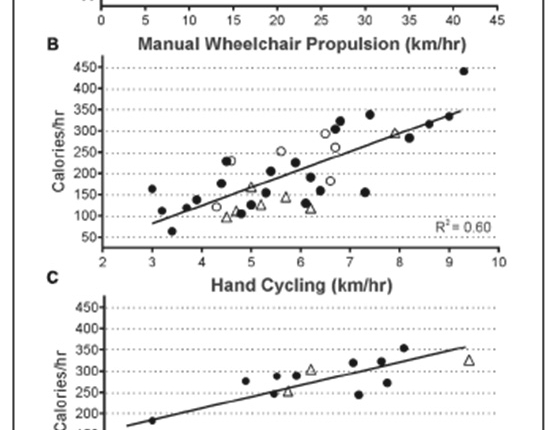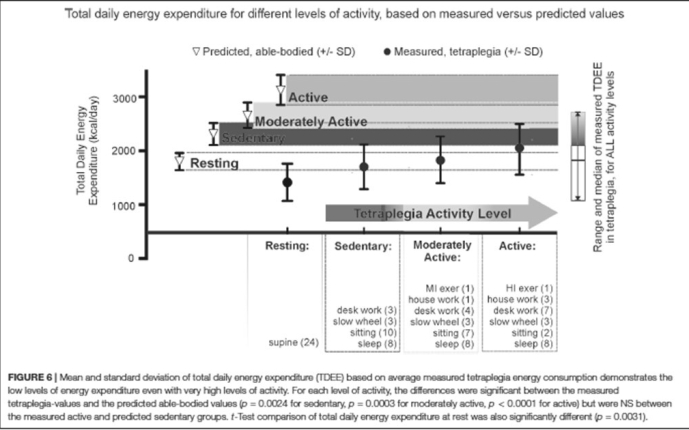https://unbfpsyc.ca1.qualtrics.com/jfe/form/SV_3QU7KNgS3G0aPHw
Energy Use After Spinal Cord Injury
Are tetraplegia-specific energy guidelines needed?By Dr. Kristine Cowley
For everyone, energy consumed in food or beverages (Calories, kcal) needs to be matched by our energy use (activity and exercise) or we will end up storing the extra energy as fat. A few years ago, we started examining resting and exercise-based energy use in people with tetraplegia. One of the articles that stemmed from this research was just published (Shea et al. 2018), and some key findings are presented here.
Specifically, we measured resting energy in 25 people with tetraplegia (C4/5 to C8; quadriplegia/cervical spinal cord injury) as well as energy use during three types of exercise (arm ergometry, wheeling & hand-cycling). We focused on those with tetraplegia because they are the most at risk for type II diabetes, obesity and cardiovascular disease compared to those with paraplegia and because there are few studies of people with tetraplegia. We observed that people with tetraplegia used a lot less energy at rest compared to what is predicted from able-bodied data, based on the person’s age, sex, weight and height (22% less for men or women). Nine study participants had resting energy use less than 1200 Calories/day.
We measured exercise-based energy use over the range of intensities that our study participants could maintain without having to stop because of fatigue. The graphs below (labeled Figure 3) show the energy data for women (empty triangles) and men (black circles) with motor-complete injury and for those with incomplete injury (empty circles). As you can see, energy use is quite low, even at the highest levels that study participants were able to maintain, ranging from as little as 50 Calories per hour to between 300-400 Calories per hour. For comparison, bicycling at 16-19 km/hr would require about 480 kcal/hr for a 175 pound able-bodied man (Ainsworth et al. 1993). We formatted these graphs so that anyone with tetraplegia can use them to estimate their energy use when exercising at the intensities shown.

FIGURE 3 – Click image to load full image
The other item from the paper to highlight concerns total daily nutritional energy consumption guidelines and tetraplegia. Anyone with spinal cord injury (SCI) knows that they need to eat less, but SCI-specific nutrition guidelines do not exist. So, if you go to a nutritionist as a person with an SCI and ask how many food Calories you should eat, you are typically told to eat fewer calories than suggested for your age, sex and height, but no one can give a very good answer on HOW MUCH LESS? Therefore, we estimated total daily energy expense (TDEE) for a range of activity in tetraplegia and compared them to their matched predicted values if they were able-bodied. As you can see in the graph below (labeled Figure 6), total daily energy expenditure values for sedentary through moderate levels of activity in tetraplegia fall well below predicted for the general population. Keep in mind that these are averages, and the nine study participants with resting energy use less than 1200 kcal/day will be the lower half of these values. The entire measured range of TDEE is shown on the right, where you can see that some people use only about 1000 kcal/day. So the first conclusion from this work is that we very likely should develop tetraplegia-specific nutritional guidelines for those needing only VERY LOW Caloric energy consumption. Such guidelines would attempt to ensure, based on carefully selected food choices, that those needing around or less than 1000 kcal/day meet their daily minimum requirements for mineral and vitamin micronutrients.

Any male with motor-complete tetraplegia can use this chart to provide an estimate of total daily energy consumption based on activity level. So, for example, if you use a reputable online food intake calculator, such as the one at nutritiondata.com, https://nutritiondata.self.com/tools/calories-burned, and enter your data (gender, age, height, weight) and ‘sedentary’ for activity level, you will get a predicted daily total for Caloric energy to consume. So, once you have your ‘predicted’ value, you can multiply it by the factors shown in the chart below for each ‘Tetraplegia Activity Level’ (0.74 – sedentary; 0.79 – moderately active; 0.88 – active). So if we use the example of a 45-year old, 5’11” male, weighing 150 pounds, the nutritiondata site would say he should consume 2298 kcal/day, when we choose a ‘sedentary’ level of activity. Based on looking at the amount of ‘activity’ you do, you can choose whether you think you are sedentary, moderately active or active. If you think you would be moderately active, doing 1 hour of exercise daily plus the equivalent of one hour of housework and wheeling for about 3 hours per day then you would multiply the ‘predicted’ value times the appropriate factor (in our example this would be 2298 x 0.79 = 1815 kcal/day). These numbers are based on averages so will over-estimate the numbers for those on the lower end of the range and will under-estimate those on the higher end of the range of values. We did not have enough female study participants to develop a female-specific chart, but the fractions provided here can serve as a starting point when making comparisons to the ‘predicted’ TDEE found for your age, gender height and weight.
In summary, those with tetraplegia can use the information provided here to estimate how much energy ‘burned’ when exercising with common forms of exercise available to those with SCI. These findings also support the need to develop tetraplegia-specific energy-balance guidelines that reflect the unique situation of those living with tetraplegia. This is especially im-portant for those with tetraplegia operating at the very low end of the energy use range that we observed.
Please direct any comments or questions to Kristine.Cowley@umanitoba.ca
References:
Ainsworth, B. E., Haskell, W. L., Leon, A. S., Jacobs, D. R., Jr., Montoye, H. J., Sallis, J. F., et al. 1993. Compendium of physical activities: classification of energy costs of human physical ac-tivities. Med Sci Sports Exerc. 25(1): 71-80.
Shea, J., Shay, B., Leiter, J. and Cowley, K. C. 2018. Energy expenditure as a function of activity level after spinal cord injury: the need for tetraplegia-specific energy balance guidelines. Front Exercise Physio. in press. and can be downloaded here: https://www.frontiersin.org/articles/


